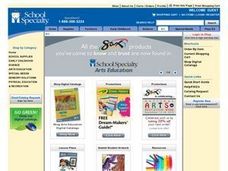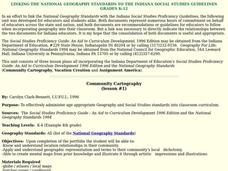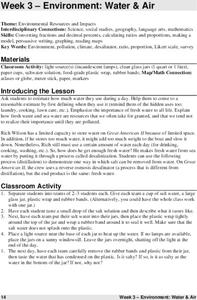Curated OER
Children in the United States and Japan
Students locate Japan on a map or globe and describe the relative location of Japan. They use the Internet to investigate cultural characteristics of children in the United States and in Japan. They use a Venn Diagram as an...
Curated OER
Desert Postcards
Students research characteristics of deserts. They present their findings in small groups to the class. Students utilize information learned about desert biomes, geography of the route of the Niger, and expeditions in their writing.
Curated OER
Country/State Flip-Book
Students produce books on a chosen state or country. The pages are cut to be the shape of the area being studied, and students creatively design each page to reflect the information being presented.
Curated OER
Yam and Eggs
Students gain knowledge about the different kinds of foods people eat around the world for breakfast. They look at a map and see if they can come up with reasonable answers as to why location may affect what people eat. Students also...
Curated OER
Introduction to African Folklore
Students are read "Anansi the Spider" to begin their discussion on continents. Using a map, they locate the continent of Africa and the country of Ghana. They discover who the Ashanti people are and view examples of their artwork. They...
Curated OER
Celebrate Your Heritage
Students investigate what countries their ancestors originally came from and locate them on a world map. They use a map to plot the ancestral path that has led to their hometown. They create a travel log outlining facts/data about...
Curated OER
Community Cartography
Learners use an inflatable globe which they wrap in plastic wrap. They use a permanent marker and outline the continents, and label major oceans and trace the equator. Students bring heir globes and use their projection for a discussion...
Curated OER
Then and Now in Las Vegas
Third graders examine the history of Las Vegas. In this Las Vegas lesson, 3rd graders learn about the history of the city as they listen to a lecture. Students then create a Las Vegas timeline and acrostic poem.
Curated OER
All About Me Museum
Learners investigate the concept of self-esteem and image with the creation of a personal display of items of significance. They put together a project composed of pictures and writings to describe themselves and are assessed according...
Curated OER
The Railroad Booms!
Students discover how the railroads contributed to the interdependence between farms and towns. Using the railroads, they describe the effect of them on western settlement and the relationship between their location and the availability...
Alabama Learning Exchange
Forces that Change the Land
Students conduct Internet research find information about the following landforms: mountains, canyons, and valleys. They create travel brochures of their findings.
Curated OER
Unite These States
Students explore the historical events and people associated with the 13 colonies. The geographic locations of the 13 colonies and ultimately, of all 50 states are investigated.
Curated OER
Michigan's Two Regions
Third graders discuss and compare upper and lower Michigan. In groups they research a list of significant events from Michigan history and then compile the information into an illustrated classroom timeline.
Curated OER
About the U.S.A.
Students research the United States and discover its different climate zones, geographical features, animal life, and various cultures. Students complete a research chart using books, encyclopedias and the internet and present their...
Curated OER
If the World Were a Village
Students examine the conditions of the global economy. As a class, they discuss the political, economic and cultural differences around the world. They review the concepts of distribution and scarcity and identify the costs and...
Curated OER
Where Did Foods Originate? (Foods of the New World and Old World)
What do papayas, peanuts, pineapples, and potatoes have in common? Why, they are foods explorers brought back to the Old World. Young researchers use the Internet to investigate how New World explorers helped change the Old World's diet....
Curated OER
Environment: Water & Air
The introduction to the instructional activity mentions a sailor's limited capacity to store drinking water on his ship. Pupils then set up an overnight experiment to remove freshwater from salt water by distillation. There is a math and...
Curated OER
Build Listening Skills With Asian Folktales
Students read five folktales. After each folktale is read students use a map to find the location of the country of the tale's origin. Next, students answer comprehension questions related to each folktale.
Curated OER
BOUND TO BE NEW HAMPSHIRE
Learners identify neighborhood, town, and state boundaries. They distinguish between natural and man-made boundaries. They identify major state geological features and explain how NH boundaries have changed over time.
Curated OER
Fish Around the World
Learners use a globe to answer questions such as which continent they live in and the country in which they live. They identify at least two bodies of water near their state and two foreign countries. In groups, they complete a...
Curated OER
This Land is Your Land - Delaware
Learners determine how land was divided and marked for boundaries in the early days of settlement in Delaware. Students mark out land on the playground according to the methods used by the early settlers. Learners write a description of...
Curated OER
Using the Four Main Directions in the Classroom
Students utilize a compass to determine where North is in the classroom. In this direction lesson, students label the four main directions. Students locate features in the classroom and describe the directions to get to them. Students...
Curated OER
The Plains Indians
Students have a better understanding of another culture other than their own. This help them to see that there were other people living in this region before us.
Curated OER
Colorado
Third graders complete a variety of activities to increase their knowledge of Colorado. They make leafprints, read and listen to stories, write fiction, make collages, participate in discussions and invite their parents to come and see...























